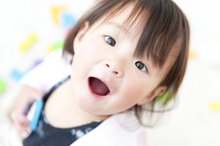Signs of Autism in a Three-Year-Old
Autism spectrum disorders -- ASDs -- are a group of developmental disorders that begin in childhood 2. Symptoms range from mild to severe. According to the Centers for Disease Control and Prevention, ASD affects 1 out of every 88 children in the United States 2. Though typically not diagnosed until the age of 3, symptoms can present during infancy. The sooner these symptoms are recognized, the sooner treatment can begin.
Social Skills
A common symptom of autism is social detachment. You may have cause for concern if your 3-year-old is not engaging in play with others. Your child may also become rigid or pull away when you try to hug or cuddle him. While many 3-year-olds find it hard to detach themselves from parents, your child may show no emotional reaction when you leave the room or take him to a sitter.
- A common symptom of autism is social detachment.
- Your child may also become rigid or pull away when you try to hug or cuddle him.
Verbal Clues
Differences in Boy & Girl Behavior
Learn More
By the age of 3, many children are forming words and short sentences. However, if your child has an autism spectrum disorder, he may not speak at all. In some cases, children with autism will begin to babble and talk and then stop suddenly. If this occurs, visit your child's doctor with your concerns. Your child may also have a difficult time expressing his needs or wants, which can easily lead to frustration. In some cases, he may simply repeat a certain sound or word over and over for long periods of time.
- By the age of 3, many children are forming words and short sentences.
- Your child may also have a difficult time expressing his needs or wants, which can easily lead to frustration.
Nonverbal Clues
Just as there are verbal clues that may indicate autism, there are also nonverbal clues. By age 3, most children will turn their heads when their name is called. Children with ASD may appear as if they do not hear you or are ignoring you. Lack of eye contact can also be a symptom of ASD. When you are speaking to your child or trying to engage him in games or conversation, he will appear as though he is in his own world, paying no attention to your attempts. If you do get his attention, you may see an expressionless face staring back at you.
- Just as there are verbal clues that may indicate autism, there are also nonverbal clues.
- Children with ASD may appear as if they do not hear you or are ignoring you.
Other Behaviors
Signs of Autism at 1 Year Old
Learn More
Some children with ASD demonstrate repetitive rocking motions or a constant flapping of their hands. They may also display a fascination or obsession with one particular toy. While 3-year-olds without ASD may have a favorite toy, they are inclined to become bored with the same item after a short while. Some children with ASD have a tendency to pick one item and play with it nonstop. He may even sit for hours with his blocks, placing them in perfect order; if his play is disturbed, he may begin screaming or become inconsolable.
- Some children with ASD demonstrate repetitive rocking motions or a constant flapping of their hands.
- While 3-year-olds without ASD may have a favorite toy, they are inclined to become bored with the same item after a short while.
Routine
Children with ASD may insist on a specific routine. When this routine is disturbed, it can cause serious behavioral problems such as tantrums or self-inflicted injury such as biting. You may find that your 3-year old wants his meals the same time each day, or his bath the same time each night. Though he can't tell you this is what he wants, he will let you know when he's not happy that his routine has been broken.
- Children with ASD may insist on a specific routine.
- Though he can't tell you this is what he wants, he will let you know when he's not happy that his routine has been broken.
Related Articles
References
- International Journal of Developmental Neuroscience: Behavioral Manifestations of Autism in the First Year of Life
- Centers for Disease Control and Prevention: Autism Spectrum Disorders (ASDs)
- European Child & Adolescent Psychiatry: Inter-Rater Reliability and Stability of Diagnoses of Autism Spectrum Disorder in Children Identified Through Screening at a Very Young Age
- Centers for Disease Control and Prevention. Screening and diagnosis of autism spectrum disorder. Updated March 13, 2020.
- Lord C, Risi S, DiLavore PS, Shulman C, Thurm A, Pickles A. Autism from 2 to 9 years of age. Arch Gen Psychiatry. 2006;63(6):694-701. doi: 10.1001/archpsyc.63.6.694. PMID: 16754843
- National Institute of Mental Health. Autism spectrum disorder. Updated March 2018.
- Centers for Disease Control and Prevention. Prevalence of autism spectrum disorder among children aged 8 years—autism and developmental disabilities monitoring network, 11 sites, United States, 2016. Published March 27, 2020.
- Cleveland Clinic. Autism. Updated July 20, 2014.
- Centers for Disease Control and Prevention. What is autism spectrum disorder?. Updated March 25, 2020.
- Taylor LE, Swerdfeger AL, Eslick GD. Vaccines are not associated with autism: an evidence-based meta-analysis of case-control and cohort studies. Vaccine. 201417;32(29):3623-9. doi:10.1016/j.vaccine.2014.04.085
Writer Bio
Based in Jamestown, Pa., Hannah Rice Myers has more than 10 years of experience as a freelance writer, specializing in the health industry. Many of her articles have appeared in newspapers, as well as "Curing Epilepsy: Hope Through Research." Rice Myers received her master's degree in nursing from Upstate Medical University in 2001.









